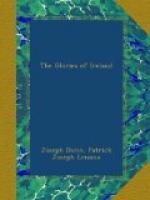Nor must the poorer Irish be forgotten. How much does the Catholic Church, both in Ireland and in America, owe to the generosity of Irish-American laborers and servant girls! Out of their scanty and hard-earned pay they have contributed much not only towards the building of the plain wooden church in the rural parishes, but also of the stately cathedrals of American cities. And many a church in old Ireland owes its completion and its adornment to the dollars given by the poor but generous Irish exiles.
And if the zeal of the Irish for religion has thus survived to the twentieth century, so also in an equally remarkable degree has their zeal for learning. We have evidence of this in the numerous primary schools in every parish, filled with eager pupils and presided over by hard working teachers; in the colleges where the sciences and the classics are studied with the same energy as in the ancient monastic schools; and in Maynooth College, which is the foremost ecclesiastical college in the world. And if there are now new universities, the National and the Queen’s, sturdy and vigorous in their youth, this does not imply that Trinity College suffers from the decreptitude of age. For among those whom she sent forth in recent times are Dowden and Mahaffy and Lecky, to name but three, and these would do credit to any university in Europe.
It would be difficult to find in any age of Irish history a greater pulpit orator than the famous Dominican, Father Tom Burke, or a more delightful essayist than Father Joseph Farrell; and who has depicted Irish clerical life more faithfully than the late Canon Sheehan, whose fame as a novelist has crossed continents and oceans? O’Connell was a great orator as well as a great political leader, and Dr. Doyle and Archbishop John MacHale were scholars as well as statesmen and bishops. We have thus an unbroken chain of great names, a series of Irishmen whom the succeeding ages have brought forth to enlighten and instruct lesser men; and Ireland, in the twentieth century, is not less attached to religion and learning than she was when Clonmacnois flourished and the saintly Carthage ruled at Lismore.
REFERENCES:
Joyce: Social History of Ancient Ireland (Dublin, 1903); Lanigan: Ecclesiastical History of Ireland (Dublin, 1822); Healy: Ireland’s Ancient Schools and Scholars (Dublin, 1896), Life and Writings of St. Patrick (Dublin, 1905); Bury: St. Patrick and his Place in History (London, 1905); Ussher’s Works (Dublin, 1847); Reeves: Adamnan’s Life of St. Columba (Dublin, 1851); Worsae: The Danes in Ireland (London, 1852); Moran: Essays on the Early Irish Church (Dublin, 1864); Stokes: Ireland and the Anglo-Norman Church (London, 1897); Mant: History of the Church of Ireland (London, 1841); Bagwell: Ireland under the Tudors (London, 1885-90); Moran: Persecutions under the Puritans (Callan, 1903); Murphy: Our Martyrs (Dublin, 1896);




